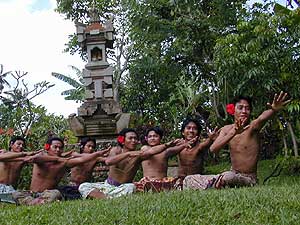|
Audio
Photos
Your Voice
|
Building a cultural bridge through monkey-chanting
September 9, 2004
 |
| The monkey chanters of Bali. Several were recruited by Ragamala Music and Dance Theater to teach Minnesota volunteers the art of "Kecak," or monkey chanting. (Photo courtesy of the Walker Art Center) |
 | |||
Minneapolis, Minn. — The Ramayana is a 2,000 year-old epic story that might be described as the Hindu equivalent of Homer's Iliad. The hero is Rama, a model figure who lived his whole life by the rules of dharma.
To be brutally brief, Rama is banished to the forest and must battle an evil demon to restore his kingdom. Ranee Ramaswamy, founder of Ragamala Music and Dance Theater in Minneapolis says the Ramayana binds the Hindu world together.
"The Ramayana is a very sacred text," she says. "And it teaches the ideal way of life is to follow your duty. If everybody followed their duty, and then there would be no chaos in the world. That's the model built behind the story."
Several years ago, Ramaswamy saw the Ramayana performed for tourists on the island of Bali. She was entranced.
"Every village in Bali has their own choruses," she says. These are community members, who perform every night. And I saw it at night, at 7:30, out by the temple, and it was like being in a dreamland."
 | |||
Ramaswamy was so transported she enlisted the Walker Art Center to recreate the experience in the Twin Cities. Sethu is a multi-cultural fusion of performance styles, including Javanese and Balinese gamelan, and South Indian dance and music.
If that isn't exotic enough, there's also monkey chanting.
Monkeys play a key role in the Ramayana. A monkey army assists the hero Rama in regaining his kingdom. The art of monkey chanting or, "kecak," (pronounced 'keh-CHACK') originated in Indonesia, which is why Ramaswamy recruited a small team of Balinese masters to teach it to Minnesota volunteers.
Team leader Dewa Berata says kechak isn't easy to learn because there are three different interlocking chants happening at the same time.
 | |||
"Three thing going on," Berata says. "The hardest, not keep your part but how to you say your part but you listen to other part."
Jim Hodges is one of several Minnesota volunteers, some who belong to the St. Paul-based Shubert Club Gamelan Society, who took up the kecak challenge.
"It's a helluva lot of fun and it's kind of silly at the same time," he says. "But it's also terrific to be doing this in an ensemble with a bunch of people who were total strangers a couple weeks ago."
Hodges and a few other volunteer performers only needed a little coaxing to demonstrate their skills.
 | |||
Hodges says when people find out he's learning the art of monkey chanting, they become extremely curious.
"People at work," he says, "they say what's it like doing this stuff? And I pull out this chart and start to do it and I feel like an idiot because it's so out of context. But here, it just fits together, it just rocks."
The enthusiasm and joy Hodges has felt during rehearsals is what the performers want the audience to feel this weekend. They believe the production is yet another example of how art can bridge cultures.
|
News Headlines
|
Related Subjects
|
